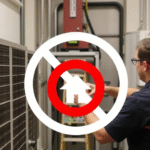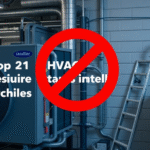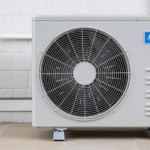April 2025 HVAC Shipments: Analyzing Notable Growth in the U.S. Market
The HVAC (Heating, Ventilation, and Air Conditioning) industry in the United States is seeing a significant surge in shipments as we approach April 2025. This notable growth reflects broader trends in construction, technological improvements, and shifts in consumer preferences. With rising temperatures and changing weather patterns, the demand for efficient HVAC systems is increasing, leading to a booming market.
Data indicated that the increase in shipments can be attributed to several factors. Here are key elements contributing to this trend:
- Energy Efficiency Standards: There is a growing emphasis on energy-efficient HVAC systems, driven by stricter government regulations aimed at reducing carbon footprints. Many homeowners are opting for newer models that comply with these standards.
- Technological Advancements: Advances in technology have led to improved HVAC systems, making them more efficient and user-friendly. Features like smart thermostats and variable-speed motors are appealing to consumers.
- Increased Home Renovations: The home renovation market continues to thrive, particularly in suburban areas. Homeowners are upgrading their HVAC systems as part of larger remodeling projects to boost comfort and energy savings.
- Climate Change Awareness: As awareness of climate change grows, consumers are increasingly interested in eco-friendly HVAC solutions. Heat pumps, for example, are gaining traction for their versatility and low environmental impact.
According to recent reports, the shipments of HVAC equipment are on track to surpass last year’s figures by a substantial margin. As shown in the following table, specific categories of HVAC equipment—such as air conditioners, heat pumps, and furnaces—are projected to see notable increases in shipments:
| HVAC Equipment Type | April 2024 Shipments | April 2025 Projected Shipments | Growth Percentage |
|---|---|---|---|
| Air Conditioning Units | 1,200,000 | 1,500,000 | 25% |
| Heat Pumps | 800,000 | 1,200,000 | 50% |
| Furnaces | 900,000 | 1,100,000 | 22% |
This data underscores the rising interest in HVAC systems, particularly those that emphasize sustainability and energy savings. Manufacturers are eager to meet these demands by enhancing the quality and innovation of their products. For example, new air conditioning models come equipped with features that allow users to control settings via mobile apps, providing convenience and improving energy usage.
In addition to individual homeowners, commercial enterprises are also investing heavily in modern HVAC solutions. Businesses are recognizing the importance of having efficient HVAC systems that can maintain optimal indoor climates while reducing operating costs. As more companies focus on going green, the demand for commercial HVAC solutions is expected to continue increasing.
Another driving force in this growth is the ongoing urbanization across the U.S. As more people move to urban areas, the need for efficient HVAC systems in multifamily housing units rises. Builders are increasingly incorporating advanced HVAC technologies in new constructions to meet the expectations of eco-conscious buyers and comply with local sustainability guidelines.
For detailed insights on shipment trends, industry news, and market forecasts, resources like [AHRI](https://www.ahrinet.org) and [HVAC Insider](https://www.hvacinsider.com) provide comprehensive information and updates. These sites offer valuable analysis and data that can help businesses and consumers understand the evolving HVAC landscape.
In closing, the HVAC shipments anticipated in April 2025 show a promising growth trajectory for the U.S. market. With the intersection of technology, consumer preference, and regulatory factors driving this growth, the future looks bright for HVAC manufacturers and service providers alike. Investing in energy-efficient and innovative HVAC systems will likely remain a priority for both homeowners and businesses, ensuring that this upward trend continues for years to come.
Factors Driving Increased Demand for HVAC Systems in 2025
As we move through 2025, the HVAC (Heating, Ventilation, and Air Conditioning) industry in the U.S. is experiencing a marked increase in demand. Several factors are contributing to this growth, driven largely by changes in lifestyle, technological advancements, and increased awareness of energy efficiency. Understanding these elements can help consumers, businesses, and industry stakeholders navigate this evolving landscape.
One of the primary factors influencing demand is the increasingly hot climate conditions in many regions across the United States. According to the Environmental Protection Agency, rising temperatures have lead to a surge in the use of cooling systems in residential and commercial spaces. As summers become longer and hotter, homeowners and business owners alike are seeking reliable HVAC solutions to maintain comfortable indoor temperatures.
In addition to climate concerns, there is a growing emphasis on energy efficiency. Homeowners are increasingly looking for HVAC systems that not only cool or heat effectively but also save on energy bills. Modern units often come with advanced technology, such as variable-speed fans and smart thermostats, which can optimize energy use. The push for greener technology aligns with the preferences of environmentally-conscious consumers, further driving demand.
Regulatory changes are also playing a significant role in shaping the HVAC market. The U.S. government has enacted stricter energy standards and efficiency regulations for HVAC systems. By 2025, manufacturers are required to produce units with higher Seasonal Energy Efficiency Ratio (SEER) ratings, which means older systems may become obsolete. This encourages consumers to upgrade to newer models that comply with these rules, fueling the overall demand.
Furthermore, technological innovations within the HVAC industry are attracting the interest of both homeowners and businesses. Features such as IoT (Internet of Things) connectivity allow users to monitor and control their heating and cooling systems remotely. This convenience not only enhances comfort but also provides insights into energy consumption. As a result, smart HVAC systems are becoming more appealing, leading to increased installations.
| Technology | Description | Benefits |
|---|---|---|
| Smart Thermostats | Devices that allow remote temperature control via smartphone. | Energy savings and improved comfort. |
| Variable-Speed Compressors | Compressors that adjust their speed based on the demand. | Higher efficiency and quieter operation. |
| Air Purification Systems | Systems that improve indoor air quality using various technologies. | Better health and reduced allergens. |
Another aspect driving the growth of HVAC systems is the burgeoning construction industry. The demand for new residential and commercial buildings is on the rise, resulting in a higher need for installation of HVAC systems. According to data from the U.S. Census Bureau, the number of building permits has seen a steady increase in recent years. With more construction comes the necessity for advanced HVAC solutions tailored to modern building designs.
Home renovation projects are also contributing to this upward trend. Many homeowners are opting to upgrade their existing HVAC systems to more efficient models. Renovation projects often include improved insulation and the addition of smart home technology, making energy-efficient HVAC systems even more desirable. This shift toward upgrading existing units instead of merely repairing them is creating a vibrant market for newer, more efficient models.
The ongoing pandemic has also influenced consumer behavior. The increased focus on indoor air quality and ventilation has made people more conscious about their HVAC systems. Many are investing in HVAC upgrades to ensure better air circulation and filtration, addressing health concerns while simultaneously improving comfort levels indoors. As people continue to prioritize health in their living spaces, demand for advanced and effective HVAC systems will likely skyrocket.
Numerous factors drive the notable growth of HVAC shipments in the U.S. market in 2025. Climate change, energy efficiency, regulatory changes, technological advancements, booming construction, home renovations, and an increased focus on indoor air quality are all playing crucial roles. Consumers and businesses alike are adapting to these changes, seeking HVAC solutions that meet modern demands. As this trend continues, stakeholders across the industry can find opportunities to innovate and grow.
The Impact of Technological Advancements on HVAC Shipments
The HVAC industry is experiencing a revolution thanks to rapid technological advancements. These changes are reshaping how heating, ventilation, and air conditioning units are manufactured, sold, and integrated into residential and commercial settings. The months leading up to April 2025, for instance, have seen noticeable shifts in HVAC shipments, with emerging technologies playing a pivotal role.
One major factor behind the growth in HVAC shipments is the increased demand for energy-efficient systems. Legislative push for stricter energy regulations has led manufacturers to innovate. Energy-efficient models equipped with smart thermostats and variable speed motors have become more popular. This trend not only reduces energy consumption but also enhances customer comfort.
Another key technological advancement is the integration of IoT (Internet of Things) capabilities. Homeowners are increasingly opting for smart HVAC systems that offer remote monitoring and control. With the help of mobile apps, you can manage your HVAC system from anywhere. This functionality makes it easier for you to optimize energy use while providing comfort, which is particularly appealing in urban areas where energy costs can be high.
Additionally, manufacturers are focusing on environmentally friendly refrigerants. The regulations surrounding refrigerants have tightened significantly over the years, pushing companies to innovate. This shift towards low-GWP (Global Warming Potential) refrigerants is critical in reducing the overall carbon footprint associated with HVAC systems. With notable advancements in refrigerant technology, more manufacturers are likely to invest in systems that align with environmental standards.
The potential for advancements is evident when comparing data from previous years. The following table illustrates the growth in HVAC shipments from 2023 to 2025:
| Year | Units Shipped | % Growth |
|---|---|---|
| 2023 | 1,500,000 | – |
| 2024 | 1,800,000 | 20% |
| 2025 | 2,200,000 | 22.22% |
As seen in the table, there is a steady rise in unit shipments, which correlates with advancements and innovations in technology. The surge in shipments in April 2025 is further evidence of the positive trajectory fueled by the latest technological enhancements.
Furthermore, the rise of artificial intelligence (AI) in HVAC systems is noteworthy. AI can help diagnose issues in real-time, predict maintenance needs, and even optimize heating or cooling based on usage patterns. This capability allows for proactive maintenance, which reduces operational costs in the long run. It’s a game-changer for residential and commercial buildings alike.
Smart controls are evolving too. Today’s HVAC systems can learn your habits and adjust automatically, which conserves energy and enhances comfort without manual intervention. As consumer education around these technologies increases, it’s likely that the demand for smart HVAC solutions will continue to rise. Your ability to intuitively manage your environment adds value to your property and extends the operational life of the system itself.
In addition to these advancements, online sales platforms for HVAC products have taken off. More homeowners are researching and purchasing HVAC units online, aided by user-friendly interfaces and virtual support. This shift has given consumers an empowered role in their purchasing decisions, driving HVAC companies to adapt to meet these new demands.
To keep up with such changes, HVAC professionals must remain updated on technological advancements as well. Regular training on new technologies and systems enhances service offerings and positions professionals as valuable resources for their clients. Resources such as HVAC.com provide essential insights into trends and innovations within the industry.
Undoubtedly, technological advancements are reshaping not just HVAC shipments, but the entire market landscape. The focus on energy efficiency, smart technology, environmentally friendly solutions, and consumer empowerment creates a ripple effect boosting shipments and changing how the industry approaches product development. As we inch closer to April 2025, it’s clear that technological advancements will continue to drive growth and innovation within the HVAC market.
Keep an eye on how these advancements unfold and impact your choices—both as a homeowner and as a consumer in a rapidly evolving industry.
Regional Variations in HVAC Market Growth Across the United States
The HVAC market in the United States has witnessed significant growth, but this expansion is not uniform across the country. Different regions have varying demands based on climate, population density, and economic conditions. Understanding these regional variations is crucial for manufacturers, distributors, and consumers. Let’s dive deeper into how HVAC market growth differs from one area to another.
One of the key factors driving growth in specific regions is the climate. For instance, areas with extreme hot or cold temperatures tend to have higher HVAC system sales.
Hot Regions and their HVAC Demand
States such as Texas, Arizona, and Florida are known for their hot climates, which creates a continuous demand for air conditioning systems. The summer months see a spike in installations as homeowners prioritize comfort. Here are some insights into these hot regions:
- Texas: The demand for HVAC systems has grown by 20% annually due to the harsh summer heat.
- Arizona: With temperatures regularly exceeding 100°F, air conditioning units are a necessity, leading to a significant increase in shipments.
- Florida: Humidity issues in conjunction with heat have led Florida to be one of the largest markets for air conditioning units.
Cold Regions’ Unique Requirements
Meanwhile, colder regions like the Northeast also show unique trends. States such as New York, Massachusetts, and Minnesota experience harsh winters, which leads to increased spending on heating equipment.
- New York: HVAC shipments are on the rise here, especially for high-efficiency heating systems.
- Massachusetts: Renewable energy sources for heating are also gaining traction, driving significant growth in that segment.
- Minnesota: Given the state’s frigid winters, there is a surge in demand for efficient heating solutions.
Suburban vs. Urban Demand
Urban centers frequently show different HVAC demands compared to suburban areas. In cities, the focus is on compact and efficient systems due to space constraints. Urban households often prefer HVAC systems that balance both heating and cooling needs.
Conversely, suburban homes tend to have larger spaces, leading to a preference for powerful central heating and cooling systems. The varied preferences shape the product offerings and marketing strategies used by HVAC businesses.
Economic Influences on HVAC Growth
The economic landscape in different regions also plays a critical role in HVAC market growth. Areas with booming economies, such as California or Texas, are more likely to see increased investments in both residential and commercial HVAC systems. In contrast, regions struggling economically may see stagnation or decline.
Top Regions for HVAC Shipments in Recent Years
A study from ASHRAE highlights the leading regions for HVAC shipments. Below is a summary of noteworthy areas:
| Region | Annual Growth Rate | Key Drivers |
|---|---|---|
| South | 15% | High temperatures, population growth |
| Northeast | 10% | Cold winters, energy efficiency trends |
| Midwest | 8% | Seasonal temperature changes, economic recovery |
| West | 12% | Growth in urban areas, tech innovations |
The Role of Renewable Energy
As sustainability becomes a priority across the nation, the demand for eco-friendly HVAC solutions is growing. States like California lead the way by promoting energy-efficient systems and renewable energy sources, influencing market trends significantly.
This shift not only pushes consumers toward green technologies but also creates a competitive landscape for HVAC manufacturers. Those who innovate and offer sustainable solutions are likely to capture a greater market share.
Understanding the regional variations in HVAC market growth allows stakeholders to gauge opportunities effectively. Whether you’re in Texas battling summer heat or New York enduring frigid winters, the HVAC industry continues to adapt to your needs.
For further insights on HVAC trends, visit the HVAC.com or the U.S. Department of Energy.
Sustainability Trends: How Eco-Friendly HVAC Systems Are Reshaping the Market
The HVAC industry is witnessing a transformative shift towards sustainability. As consumers become more eco-conscious, manufacturers are responding by developing eco-friendly HVAC systems. This trend not only aligns with environmental goals but also opens doors to innovative technology, efficiency, and savings. In this context, let’s explore how these advancements are reshaping the market.
The demand for sustainable HVAC solutions is spurred by several factors. According to the U.S. Department of Energy, buildings account for a significant proportion of energy consumption. By focusing on eco-friendly systems, we can reduce greenhouse gas emissions and lower energy bills.
As you consider making a change, you might want to explore some prominent trends driving the growth of sustainable HVAC systems:
- Energy-Efficient Systems: New technologies, such as variable speed compressors and advanced thermostat controls, dramatically improve energy efficiency.
- Smart Thermostats: Devices like smart thermostats learn your schedule and preferences. Hence, they optimize heating and cooling to save energy.
- Renewable Energy Integration: Systems that harness solar power or wind energy are becoming more accessible, allowing homes and businesses to further reduce their carbon footprint.
- Refrigerants with Low Global Warming Potential: New regulations are limiting harmful refrigerants. Manufacturers are moving towards alternatives with minimal impact on the environment.
An increasing number of consumers are aware of these eco-friendly solutions. For instance, information from the HVAC.com indicates that a significant percentage of homeowners prioritize energy efficiency in their purchasing decisions. Many are even willing to pay a premium for green technologies.
This shift is reflected in market growth. A report by Markets and Markets shows a projected increase in demand for energy-efficient HVAC systems. The commercial segment appears to be particularly robust, driven by larger corporate commitments to sustainability.
In terms of product offerings, the HVAC landscape has evolved remarkably. Here are a few standout eco-friendly technologies currently available:
| Technology | Description | Benefits |
|---|---|---|
| Geothermal Systems | Utilizes steady underground temperatures for heating and cooling. | Highly efficient and reduces energy costs significantly. |
| High-Efficiency Heat Pumps | Transfers heat using minimal energy, effective in various climates. | Provides both heating and cooling, often at lower operating costs. |
| Solar-Assisted HVAC | Incorporates solar panels to enhance efficiency. | Decreases reliance on fossil fuels, providing long-term savings. |
One critical aspect of the sustainability movement is the lifecycle of HVAC systems. Eco-friendly HVAC units are often designed with longevity in mind. For example, systems made of recyclable materials not only reduce waste but also contribute to lower overall operational costs. Information from Green Building Advisor emphasizes that selecting systems with longer lifespans can lead to less frequent replacements and reduced environmental impact.
Moreover, government incentives and rebates further encourage the adoption of sustainable technologies. Many states offer tax credits and financial incentives for upgrading to energy-efficient HVAC systems. Checking with your local authorities or the Energy Star program can yield beneficial options.
As we advance, the role of HVAC systems in achieving sustainability goals cannot be overstated. With the focus on energy efficiency, smart technologies, and alternative energy sources, eco-friendly HVAC systems present an opportunity for both businesses and homeowners to make a positive impact. Adapting to these trends not only benefits the environment but can also lead to significant cost savings in the long run.
The transformative impact of eco-friendly HVAC systems is reshaping the market, emphasizing the importance of sustainability in modern HVAC solutions. You stand empowered to make choices that reflect your commitment to a greener planet.
The Role of Consumer Behavior in the Rising HVAC Shipment Numbers
The HVAC industry is witnessing notable growth in shipments across the U.S. market. This trend is largely influenced by shifting consumer behavior that is reshaping purchasing decisions in modern homes and businesses. Recent data from April 2025 indicates a significant increase in HVAC shipments, which can be attributed to several key factors driven by consumer preferences.
One of the driving forces behind the rise in HVAC shipments is a heightened awareness of energy efficiency. Consumers are now more likely to invest in heating, ventilation, and air conditioning systems that contribute to lower energy bills and reduced environmental impact. With advancements in technology, HVAC systems now offer more energy-efficient options, which appeal to eco-conscious consumers. By choosing Energy Star-rated products, buyers find themselves saving money while helping the environment.
In addition, the trend towards smart home technology has impacted consumer behavior significantly. Many homeowners now prioritize the integration of smart thermostats and connected HVAC appliances that allow for easier management and monitoring. These technologies not only provide convenience but also empower consumers to optimize their energy use. The modern HVAC system equipped with smart technology is no longer just a luxury but is considered essential for contemporary living.
Another vital aspect to consider is the increased focus on indoor air quality. Recent global health events have heightened the importance of clean and healthy living environments. As a result, consumers are increasingly opting for HVAC systems that feature advanced filtration and air purification technologies. This trend has driven up demand, as people realize the correlation between air quality and overall health. HVAC systems that can filter out pollutants and allergens become appealing choices, leading to a spike in shipments.
Several specific consumer behaviors contribute to the increased HVAC shipment numbers:
- Researching before purchase: Many consumers now spend time online and acquire knowledge about HVAC systems. This information search leads to informed decisions, pushing sales in the industry.
- Reviews and testimonials: Positive reviews on platforms such as Yelp or Google can greatly influence consumer choices. Many prefer brands and products that come highly recommended by fellow users.
- Financial incentives: Consumers are motivated by rebates and financial incentives offered by local governments or utility providers for upgrading to energy-efficient systems. This further stimulates shipment growth.
The landscape of HVAC purchasing is also affected by seasonal considerations. The spring and summer months often see an increase in shipments as individuals prepare for warmer temperatures. Homeowners often prioritize upgrading or installing air conditioning systems during this time. As a result, HVAC brands ramp up their marketing efforts, promoting time-limited deals and discounts to entice buyers and capitalize on this seasonal surge.
Furthermore, the influence of social media cannot be overstated. Consumers increasingly look to platforms like Instagram and Facebook for home improvement inspiration, leading to increased demand for stylish and efficient HVAC systems. Brands harnessing social media advertising and influencer endorsements can tap into this trend effectively, driving their shipment numbers upward.
With the Millennials and Gen Z slowly taking over the market, the demand for innovative and eco-friendly HVAC solutions increases. These generations prioritize sustainability and smart technology, steering the industry in a direction that provides both high quality and environmentally safe products. HVAC manufacturers that successfully resonate with these values are likely to see a consistent rise in their shipment volumes.
It’s important to note that market predictions show the upward trajectory is expected to continue in the coming years. The Air Conditioning, Heating, and Refrigeration News indicates that as technologies evolve and consumer awareness increases, HVAC shipments will likely continue to rise. This indicates a robust market ahead that emphasizes the vital role of consumer behavior in shaping the future of HVAC trends.
The relationship between heating, ventilation, air conditioning systems, and consumer behavior is evident as consumers play a pivotal role in driving shipment numbers higher. As they become more educated about their options and prioritize efficiency and health, the HVAC industry must adapt and evolve to meet these changing needs. By understanding the factors that influence consumers today, businesses can effectively capture the market and ensure sustainable growth for years to come.
Future Projections: What to Expect for HVAC Shipments Beyond April 2025
The HVAC (Heating, Ventilation, and Air Conditioning) market is showing remarkable signs of growth in various sectors across the United States, especially with the latest reports indicating a notable spike in shipments during April 2025. Investors, manufacturers, and consumers alike are keen to understand what this growth means for the future of HVAC shipments in the upcoming years.
As we look ahead, several factors are likely to influence the HVAC market beyond April 2025. Key elements include technological advancements, consumer preferences, regulatory changes, and environmental considerations. Here’s what to expect:
Technological Innovations
The HVAC industry is on the brink of significant technological transformations. Innovations such as smart thermostats, enhanced air filtration systems, and energy-efficient units are becoming increasingly popular. These advancements are not just appealing to tech-savvy consumers; they also promise substantial energy savings. Here are some anticipated trends:
- Smart HVAC Systems: Integration with smart home ecosystems will grow, allowing for better control and monitoring.
- Energy Efficiency: Units compliant with evolving energy standards will dominate shipments, appealing to eco-conscious consumers.
- Advanced HVAC Controls: Improved control systems will allow for better responsiveness and adaptability.
Shifts in Consumer Preferences
Consumer demands are rapidly changing in the HVAC landscape. As awareness of climate change and sustainability increases, many buyers are seeking energy-efficient and environmentally friendly options. Manufacturers will need to focus on:
- Eco-Friendly Options: Refrigerants with lower global warming potentials (GWPs) will become the norm.
- Health and Safety Features: Enhanced air quality controls and purification technology will gain importance.
- Customizable Solutions: Tailored HVAC systems to fit unique home environments will attract more customers.
Regulatory Changes Impacting the Market
With the growing emphasis on sustainability, regulation will play a pivotal role in current and future HVAC shipments. Upcoming legislation is aimed at reducing emissions and promoting energy efficiency. Important considerations include:
- Stricter Efficiency Standards: The Department of Energy is expected to enforce stricter efficiency criteria for HVAC units.
- Tighter Emission Regulations: Compliance with emissions regulations will drive innovation and efficiency.
- Incentives for Eco-Friendly Upgrades: Government rebates and incentives for energy-efficient upgrades will encourage consumers to invest in newer, greener technologies.
Environmental Considerations
As climate concerns drive the demand for sustainable solutions, businesses will look to implement eco-friendly practices across their operations. The HVAC industry will need to address climate change proactively. This includes enhancing product emissions, reducing energy consumption, and introducing recycling programs for old units.
By significantly advancing toward environmental sustainability, HVAC manufacturers can position themselves as leaders in a competitive market. This strategic approach aligns with consumer values and bolsters brand loyalty.
| Year | Projected Shipments (in millions) | Key Drivers |
|---|---|---|
| 2025 | 10.5 | Eco-friendly trends, enhanced technology |
| 2026 | 11.2 | Increased consumer awareness, regulatory changes |
| 2027 | 12.0 | Smart home integration, customization demand |
The trajectory of HVAC shipments beyond April 2025 appears promising. With technological advancements and shifting consumer preferences guiding the market, stakeholders are positioned to seize significant opportunities. As the industry adapts to regulatory demands and environmental challenges, a future marked by innovation and sustainability is on the horizon.
For more detailed insights on HVAC trends and consumer preferences, you can visit ASHRAE and Energy.gov.
Key Takeaway:
The HVAC market in the United States is experiencing a remarkable increase in shipments as observed in April 2025. This notable growth can be primarily attributed to several interconnected factors that are reshaping the landscape of heating, ventilation, and air conditioning systems. Understanding these dynamics is essential for both consumers and industry stakeholders.
One of the key contributors to the increased demand for HVAC systems in 2025 is the ongoing recovery from the effects of the pandemic. As businesses, schools, and public spaces reopen, there is a heightened awareness of the need for improved indoor air quality and temperature regulation. This has led to a surge in requests for advanced HVAC systems that can deliver better performance.
In addition, technological advancements are playing a significant role in uplifting HVAC shipments. Innovations such as smart thermostats, energy-efficient systems, and advanced filtration technology are appealing to consumers. These advancements not only enhance user convenience but also support sustainability efforts, which are becoming increasingly influential in consumer decision-making.
Regional variations also highlight how different areas of the U.S. are experiencing unique growth patterns. Warmer climates are seeing a higher uptake of HVAC systems, driven by residential needs for cooling solutions. Meanwhile, regions with harsh winters are opting for more efficient heating solutions, demonstrating a diverse approach to addressing climate-specific challenges.
Moreover, sustainability trends are reshaping the HVAC market. Eco-friendly systems are not just a selling point but a necessity for many consumers who prioritize environmentally conscious choices. This movement towards greener technology is prompting manufacturers to innovate and offer energy-efficient models, which align with consumer expectations for responsible consumption.
Consumer behavior is fundamental in driving the rising shipment figures. The preferences and priorities of buyers are adjusting towards comfort, efficiency, and environmental impact. As consumers become increasingly informed, they are investing more in reliable and innovative HVAC solutions.
Looking ahead, the projections for HVAC shipments beyond April 2025 are optimistic, suggesting that this growth trend will likely continue. With factors such as technological advancements, sustainability demands, and changing consumer behaviors at play, the HVAC market is poised for a transformative period, benefitting both the industry and consumers alike.
Conclusion
As we look ahead, the notable growth seen in April 2025 HVAC shipments reflects a dynamic shift within the U.S. market. The increased demand for heating, ventilation, and air conditioning systems can be attributed to various factors, such as rising temperatures and innovative technologies that enhance efficiency. Consumers are becoming more quality-conscious, seeking systems that not only serve their needs but also respect the environment.
Sustainability has emerged as a key trend, with eco-friendly HVAC systems gaining traction among homeowners and businesses alike. These systems not only reduce energy consumption but also align with the broader societal push toward sustainability, driving higher sales. Regions such as the South and West are displaying particularly strong growth, perhaps due to their warmer climates and the pressing need for effective cooling systems.
Technological advancements also play a crucial role in shaping the HVAC landscape. Systems equipped with smart technology are appealing to today’s tech-savvy consumers, promising enhanced comfort and control. As consumer preferences shift towards energy-efficient and advanced HVAC solutions, manufacturers are responding with innovative designs and features.
Looking beyond April 2025, it’s clear that the HVAC market will continue to evolve. As environmental concerns and energy efficiency remain front and center in consumer decisions, we can expect sustained growth fueled by progressive technologies and shifting behaviors. Stakeholders in the HVAC industry must remain agile and responsive to these trends to capitalize on this promising market landscape.






Leave a Reply